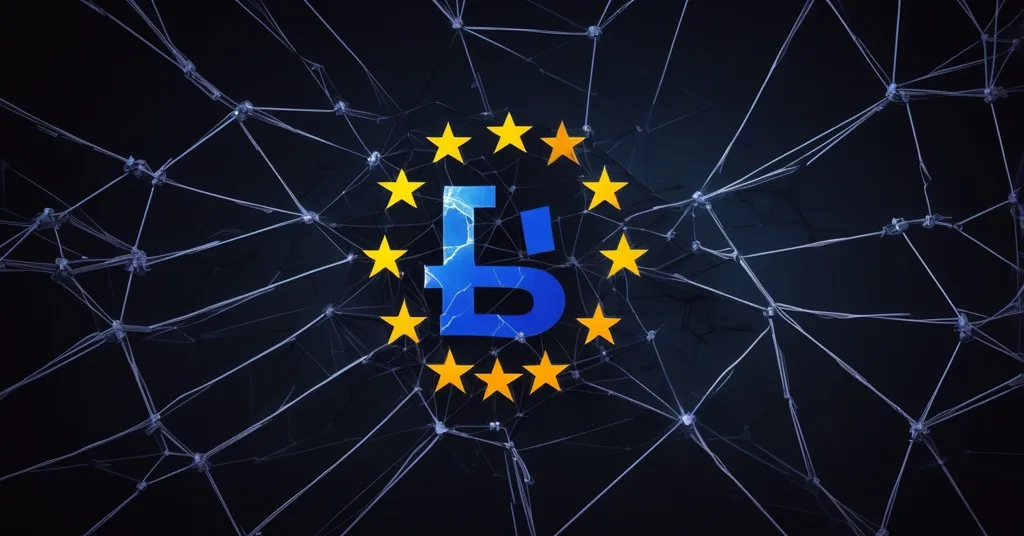EU Cracks Down on Ruble-Backed Stablecoin A7A5 in Sanctions Blitz

EU Targets Ruble-Backed Stablecoin A7A5 in Aggressive Sanctions Push
The European Union is drawing a hard line against A7A5, a ruble-backed stablecoin with deep ties to sanctioned Russian entities, as it ramps up efforts to block Moscow’s financial escape routes. With a market cap nearing $500 million, A7A5 isn’t just a blip on the radar—it’s the largest non-U.S. dollar stablecoin globally, but its shadowy backers have made it a prime target for Western regulators aiming to enforce sanctions post-Ukraine invasion.
- Sanctions Hammer: EU plans to ban all transactions with A7A5 and target linked banks in Russia, Belarus, and Central Asia.
- A7A5 at a Glance: Ruble-pegged, $496 million value, 41.6 billion tokens, and $68 billion in transactions.
- Geopolitical Flashpoint: Tied to Russia’s bid to dodge Western financial restrictions since 2022.
What is A7A5? A Ruble-Backed Heavyweight
Let’s get straight to the facts about A7A5. Launched in February, this stablecoin is issued in Kyrgyzstan and pegged 1:1 to the Russian ruble, with its fiat reserves supposedly sitting in Kyrgyz banks. It’s no small-time experiment—with 41.6 billion tokens in circulation as of late September, valued at $496 million, and a transaction volume hitting $68 billion, A7A5 commands a staggering 43% of the $1.2 billion non-U.S. dollar stablecoin market, per CoinMarketCap and DefiLlama data. That’s a hefty footprint for a token that’s barely been around for a year. It operates as a cross-chain digital ruble on major blockchain platforms like Ethereum and Tron, meaning it can zip across different networks like a car switching highways, making it incredibly versatile for users. Add to that a promise of daily passive income for holders, and you’ve got a financial tool that’s turning heads.
For the uninitiated, stablecoins are a breed of cryptocurrency designed to keep a steady value by being tied to an asset—usually a fiat currency like the U.S. dollar, or in this case, the ruble. They act as a stable bridge between the volatile crypto world and the predictability of traditional money, often used in decentralized finance (DeFi) for payments, remittances, or as a safe haven during market swings. A7A5’s ruble peg positions it as a bold alternative to the global dominance of the U.S. dollar in trade and finance, especially in regions tied to Russian economic interests.
Sanctions Evasion: Why the EU Is Striking Hard
So why is the EU gunning for A7A5 with such ferocity? Since Russia’s invasion of Ukraine in 2022, Western powers—including the U.S., UK, and EU—have rolled out crippling sanctions to cut Moscow off from global financial systems. They’ve blocked access to SWIFT, the international banking messaging network, and frozen assets, leaving Russian businesses scrambling for workarounds. Enter A7A5, which has become a go-to tool for sanctions evasion—think of it as a digital backdoor for a Russian firm to pay a Central Asian supplier without ever touching a Western bank. Deals that would take months through traditional channels are reportedly settled in just five working days using this stablecoin. The EU’s response, as detailed in a recent report on their sanctions push against ruble-backed stablecoins, is a full-force crackdown, proposing to ban all direct and indirect transactions between EU entities and A7A5 while targeting banks in Russia, Belarus, and Central Asia facilitating these crypto payments. This is no gentle nudge; it’s a deliberate move to smash Moscow’s underground financial networks.
The Dark Side of Innovation: A7A5’s Toxic Backers
Now, let’s talk about who’s behind A7A5, because this is where the stench of trouble really kicks in. The stablecoin was developed by A7, a cross-border payments company co-owned by two deeply problematic players. First, there’s Ilan Shor, a 37-year-old Moldovan fugitive banker wanted for a $1 billion fraud, holding a 51% stake. Then there’s Promsvyazbank (PSB), a Russian state-owned lender with a 49% share, tightly woven into Russia’s military-industrial complex. Both Shor and PSB have been under Western sanctions since 2022, with A7 itself hit earlier this year. Toss in Garantex, a sanctioned Russian crypto exchange that helped launch A7A5 and has since morphed into a successor called Grinex, and you’ve got a lineup that screams red flags. These aren’t freedom-fighting innovators; they’re actors with a track record of skirting accountability, using blockchain tech as a shield.
The controversy flared further at the recent Token2049 conference in Singapore, where A7A5’s presence sparked heated debates about sanctions compliance and oversight in a borderless digital economy. Industry insiders were left asking: How do you regulate a decentralized asset that laughs in the face of traditional borders? A7A5’s own Telegram channel doesn’t shy away from grand claims, boasting that it has:
“Proven that a national digital currency can be not only an alternative to the dollar but also a driver of global change.”
Sure, global change—if you count dodging sanctions as changing the world. That kind of rhetoric might sound inspiring on a chat app, but it’s hard to swallow when the token’s tied to a regime waging war and a fraudster on the lam.
Can A7A5 Be Defended? The Case for Financial Sovereignty
Let’s flip the script for a moment and play devil’s advocate. A7A5, shady as its backers may be, does embody a sliver of blockchain’s promise—decentralization, financial sovereignty, and a direct challenge to the stranglehold of the U.S. dollar in global trade. For nations under economic siege, whether justly or not, tools like this offer a lifeline to keep commerce alive outside a system that’s often weaponized against them. Imagine a small Russian business owner, cut off from international markets, using A7A5 to pay for critical imports in days rather than months. Isn’t that a glimpse of what a post-dollar world could look like? And shouldn’t we, as champions of disrupting the status quo, at least nod to the ingenuity of non-dollar stablecoins popping up globally, from China’s digital yuan experiments to regional tokens in Latin America?
But let’s not get carried away with idealism. Innovation doesn’t get a free pass when it’s orchestrated by state actors and fugitives to evade accountability. As much as we root for effective accelerationism and shaking up corrupt systems, A7A5 isn’t the hill to die on. It’s a centralized stablecoin, backed by fiat in questionable banks, not a true decentralized rebel like Bitcoin. Its mechanics might be clever—transactions flowing on Tron or Ethereum from a Russian exporter to a Kyrgyz buyer—but its purpose reeks of exploitation, not emancipation.
Lessons for the Crypto Community: A Double-Edged Sword
The saga of A7A5 isn’t just a geopolitical drama; it’s a wake-up call for the crypto community, from Bitcoin maximalists to altcoin enthusiasts. On one hand, it exposes the raw power of blockchain to bypass traditional barriers, a core reason we celebrate this tech. Bitcoin itself, born from the 2008 financial crisis, was a middle finger to centralized corruption. But A7A5 isn’t Bitcoin—it’s a political pawn, not the people’s money. Its ties to sanctioned entities risk painting the entire crypto space with a dirty brush. If regulators overreact, as they did with the Tornado Cash sanctions in 2022—where a decentralized privacy tool was targeted for enabling illicit transactions—the fallout could hit legitimate players too. DeFi protocols, exchanges, even Bitcoin, might face tighter scrutiny as governments scramble to plug holes exploited by bad actors.
Then there’s the role of platforms like Ethereum and Tron, which host A7A5. Their involvement could drag them into the regulatory crosshairs, raising questions about whether blockchain networks can or should police their users. Reports from firms like Chainalysis show a spike in crypto use in sanctioned regions, with stablecoins often at the forefront. A7A5’s $68 billion transaction volume isn’t just a number—it’s a signal of how much money is moving outside traditional oversight, dwarfing many smaller stablecoins and rivaling some legacy payment systems. The crypto industry faces a choice: self-police through transparency initiatives or risk having heavy-handed rules imposed. We’re all for freedom, but we’ve got zero patience for scammers and state-backed schemes masquerading as progress. A7A5 might be a tech marvel, but it’s a moral minefield.
What’s Next for Crypto Regulation?
The EU’s looming sanctions on A7A5 are a stark reminder that the crypto world isn’t a lawless playground—it’s a battleground where tech, politics, and power collide. This isn’t just about one token; it’s about setting a precedent. Will other nations follow Russia’s lead, launching state-backed stablecoins to sidestep economic isolation? And will the EU’s actions ripple into broader crypto policies, tightening the noose on decentralized systems that have nothing to do with geopolitics? The U.S. Treasury’s August moves against A7A5’s network and the UK’s sanctions on linked Kyrgyz banks show a coordinated Western front. Yet, enforcing compliance in a digital, borderless economy remains a Herculean task. As we track this unfolding story, one thing is clear: while we champion Bitcoin and blockchain to redefine money and liberty, we can’t ignore projects that twist those ideals into tools of evasion. The fight for a decentralized future continues, but not without hard truths.
Key Takeaways and Questions on A7A5 and EU Crypto Sanctions
- What is A7A5, and why is it a big deal in the stablecoin market?
A7A5 is a ruble-backed stablecoin issued in Kyrgyzstan, pegged to the Russian ruble, with a $500 million market cap, making it the largest non-U.S. dollar stablecoin and a major force in alternative finance. - Why is the EU imposing sanctions on A7A5?
The EU is targeting A7A5 due to its links to sanctioned Russian entities like Promsvyazbank, as it enables payments that help Moscow bypass Western financial restrictions post-Ukraine invasion. - Who are the controversial figures and groups behind A7A5?
A7A5 was created by A7, co-owned by fugitive Moldovan banker Ilan Shor and Russian state-owned Promsvyazbank, both under sanctions, with ties to the blacklisted crypto exchange Garantex. - How does A7A5 work, and what makes it appealing?
Running on Ethereum and Tron, backed by fiat in Kyrgyz banks, A7A5 offers rapid cross-border settlements for Russian businesses and daily passive income, sidestepping traditional banking delays. - What broader challenges does A7A5 highlight for crypto?
It reveals the tension between blockchain’s decentralized promise and regulatory realities, showing how digital assets can be exploited for sanctions evasion while complicating global enforcement efforts.



